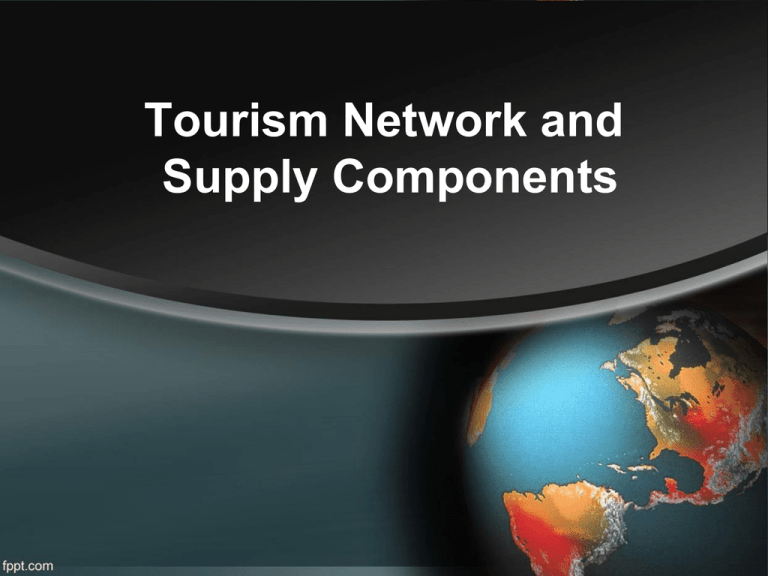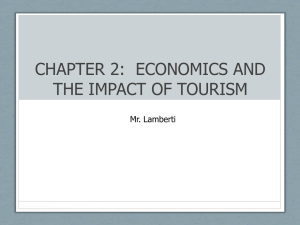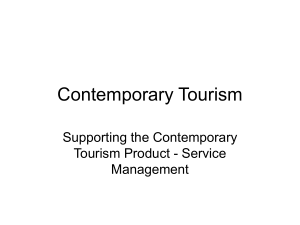Tourism Network & Supply Components: A Presentation
advertisement

Tourism Network and Supply Components The travel industry is the composite of organizations, both private and public, that are involved in the development, production, and marketing of products and services to serve the needs of the travelers. (Gee and Makens, 1997) Principles of Tourism 1 By: Zenaida L. Cruz, Ph.D. 2 • Businesses and corporations are regarded as components of the travel industry classified as: – Direct providers – Support services – Developmental organizations Principles of Tourism 1 By: Zenaida L. Cruz, Ph.D. 3 Direct Providers • Includes businesses that are associated with travel, such as airlines, hotels, restaurants, ground transportation, travel agencies and retail shops. • These businesses provide services, activities, and products that are consumed and/or purchased directly by travelers. • They represent the sectors of the industry that are visible to the travelers. Principles of Tourism 1 By: Zenaida L. Cruz, Ph.D. 4 Support Services • Lends support to direct providers. • It includes specialized services such as tour organizers, travel and trade publications, hotel management firms, and travel research firms. • It also includes basic supplies and services such as contract laundry and contract food services. • Support services sell goods and services directly but not exclusively to tourists. Principles of Tourism 1 By: Zenaida L. Cruz, Ph.D. 5 Developmental Organization • It includes planners, government agencies, financial institutions, real estate developers and educational and vocational training institutions. • These organizations deal with tourism development which tend to be more complex and broader in scope than the production of daily travel services. • The decisions and results of tourism development are more long-term in nature than the first two categories which deal more with operations. Principles of Tourism 1 By: Zenaida L. Cruz, Ph.D. 6 Tourism Supply Components 1. Natural Resources 2. Infrastructure 3. Superstructure 4. Transportation and transportation equipment 5. Hospitality Resources Principles of Tourism 1 By: Zenaida L. Cruz, Ph.D. 7 Natural Resources • Includes elements in an area for the use and enjoyment of visitors such as climate, landforms, terrain, flora, fauna, bodies of water, beaches, natural beauty and water supply for drinking, sanitation and similar uses. • The physical characteristics of an area can be generalized as natural scenery, climate, and environment. Principles of Tourism 1 By: Zenaida L. Cruz, Ph.D. 8 Infrastructure • Consists of all underground and surface developmental construction such as water supply systems, sewage disposal systems, gas lines, electrical and communication systems, drainage systems and other constructed facilities such as highways, airports, rail roads, roads, drives, parking lots, parks, night lighting, marinas and dock facilities, bus and train station facilities and similar tourist service installations. Principles of Tourism 1 By: Zenaida L. Cruz, Ph.D. 9 Superstructure • The above ground facility services such as airport buildings, passenger traffic terminals, hotels, motels, resorts, restaurant, shopping centers, places of entertainment, museums, stores, and similar structures. Principles of Tourism 1 By: Zenaida L. Cruz, Ph.D. 10 Transportation and Transportation Equipment • Includes items such as ships, airplanes, trains, buses, limousines, taxis, automobiles, cog railways, aerial tramway, and similar passenger transportation facilities. Principles of Tourism 1 By: Zenaida L. Cruz, Ph.D. 11 Hospitality Resources • Hospitality resources refers to the general feeling of welcome that the visitors receive while visiting a destination area. • It is the way that tourist services is delivered by service providers. As well as the general feeling of warmth from the local population. Principles of Tourism 1 By: Zenaida L. Cruz, Ph.D. 12 Hospitality Resources • Tourists will have a more enjoyable vacation if they feel welcomed by the host population and will certainly feel awkward and unhappy if they feel resented. • Hospitality resources can be improved by training tourism personnel to be hospitable and encouraging positive feelings toward tourism and tourists by the general public. Principles of Tourism 1 By: Zenaida L. Cruz, Ph.D. 13 Hospitality Resources • Include the cultural wealth of an area which makes possible the successful hosting of tourists. Examples are the welcoming spirit of tourist business employees, attitudes of the residents towards visitors, courtesy, friendliness, sincere interest, willingness to serve and to get better acquainted with visitors, and other manifestations of warmth and friendliness. • It also includes the cultural resources of an area such as fine arts, literature, history, music, dramatic art, dancing, and shopping. Principles of Tourism 1 By: Zenaida L. Cruz, Ph.D. 14 Hospitality Resources • Hospitality resources can be improved by training tourism personnel to be hospitable and encouraging positive feelings towards tourism and tourists by the general public. • Hospitality training aims to motivate service providers to be hospitable in dealing with tourists. • It is assumed that providing more hospitable services will result in a more satisfied tourist who will be inclined to return and advertise to other potential tourists through word of mouth. Principles of Tourism 1 By: Zenaida L. Cruz, Ph.D. 15 • To enable service providers to render hospitable services, it is necessary to change their present behavior. • This change of behavior is brought about by a change in attitude and an increase in the level of knowledge. • The three aspects of attitudes are toward self, toward others and toward the tourism industry. Principles of Tourism 1 By: Zenaida L. Cruz, Ph.D. 16 • Attitude toward self – If an individual’s self-esteem or attitude toward self is low, that individual will tend to behave in such a way that the feedback from others will confirm the low opinion of himself. – Hence, it is necessary to change the individual’s perception of self in order to improve his behavior. – If service providers can be made to believe that they and their work is important, their work and their actions towards tourist will reflect this feeling. Principles of Tourism 1 By: Zenaida L. Cruz, Ph.D. 17 • Attitude toward others – Service providers should be assisted in developing positive feelings toward fellow employees and tourists that will result in positive behavior toward the tourists. – This can be achieved by training the individual regarding teamwork and interdependence in getting the job done. Principles of Tourism 1 By: Zenaida L. Cruz, Ph.D. 18 • Attitude toward the tourism industry – A positive attitude of service providers towards tourists can be brought about only when employees are made aware of how important tourism is to their country, city and community. – By being aware of the amount of revenue, jobs, taxes generated and the dispersion the tourist dollar throughout the community, employees may become convinced of the economic and social significance of the industry of which they are a part. Principles of Tourism 1 By: Zenaida L. Cruz, Ph.D. 19 Community Awareness Programs • Although the tourists is most directly affected by the degree of hospitality shown by service providers, the overall feeling of welcome within a community will also enhance or detract from the vacation experience. • Residence of a destination area cannot be trained to act in a hospitable manner toward tourists, but a community awareness program can help develop a more positive attitude toward the tourists. • The aims of the program are to build acceptance of tourism and to build an understanding of the tourist. Principles of Tourism 1 By: Zenaida L. Cruz, Ph.D. 20 The End 21









